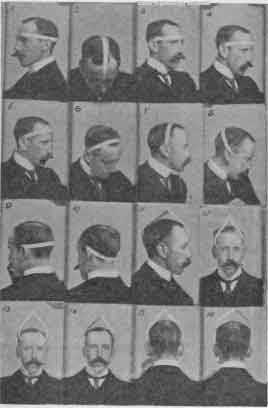Phrenology Measurements
From: John van Wyhe's The History of Phrenology on the Web

1. Circumference. From centre of forehead around the head across the most prominent part of occiput.
ARCHES.
2. Occipito-Frontal. (Longitudinal measure) from glabella at root of nose over top of head to most prominent part of occiput.
3. Lower Frontal. Between upper insertion of ear, over glabella. (Mark distance from ear to eyebrow.)
4. Middle Frontal. Over centre of forehead.
5. Upper Frontal. Over frontal eminences. (Mark distance to frontal eminences.)
6. Posterior Frontal. Across anterior border line of hair.
7. Anterior Parietal. Vertically across head.
8. Posterior Parietal. Across parietal eminences. (Mark distance to parietal eminence.)
9. Occipital. Across most prominent part of occiput.
10. Cerebellar. Between upper insertion of ear, across nape of neck at junction of occipital bone.
DIAMETERS.
11. Longitudinal. From glabella to most prominent part of occiput.
12. Lower Frontal. Between the two external angular processes of frontal bone at outer corner of eye.
13. Upper Frontal. Between two points above external angular processes on line of frontal eminences.
14. Middle Temporal. Between the two most projecting portions of temporal bone in a vertical line above opening of ear.
15. Posterior Temporal. Between two points just above and behind the mastoid processes behind the ear.
16. Bi-Parietal. Between the two parietal eminences.
Writings about phrenology
Cooter, R. (1976). Phrenology and British alienists, c. 1825-1845. Medical History, 20, 1-21; 135-151.
Cooter, R. (1976). Phrenology: The provocation of progress, History of Science, 14, 211-234.
Cooter, R. (1984). The cultural meaning of popular science: Phrenology and the organization of consent in nineteenth-century Britain. Cambridge, UK: Cambridge University Press.
Davies, John D. (1955). Phrenology: Fact and science: A nineteenth-century crusade. New Haven: Archon Books.
De Giustino, D. (1975). Conquest of mind: Phrenology and Victorian social thought. London: Croom Helm.
Greenblatt, S. (1995) Phrenology in the science and culture of the 19th century, Neurosurgery , 37, 790-805
Hedderley, F. (1970). Phrenology: A study of mind. London: Fowler.
Macmillan, M. (2002). An odd kind of fame: stories of Phineas Gage. Boston, MA: MIT Press.
McCandless, P. (1992). Mesmerism and phrenology in antebellum Charleston: 'Enough of the marvelous.' Journal of Southern History, 58, 199-230.
Riegel, Robert E. (1933). The introduction of phrenology to the United States, The American Historical Review, 39, 73-78.
Shapin, Steven (1975). Phrenological knowledge and social structure in nineteenth-century. Annals of Science, 32, 219-232.
Shapin, Steven (1978). The politics of observation: Cerebral anatomy and social interests in the Edinburgh phrenological debates. In R. Wallis (Ed.) On the margins of science: The social construction of rejected knowledge. Sociological Review Monographs, 27, pp. 139-178.
Shapin, Stephen (1979). Homo phrenologicus: Antropological perspectives on an historical problem. In B. Barnes and S. Shapin (Eds.) Natural order: Historical studies in scientific culture (pp. 41-71). London: Sage.
Stern, Madeleine, B. (1971). Heads and headlines: The phrenological Fowlers. Norman, OK: University of Oklahoma Press.
Swerling, Stephanie (1999). Pseudoscience in antebellum Athens. Retrieved December 20, 2005. http://www.arches.uga.edu/~mgagnon/students/Swerling.htm#3
Taylor Stoehr (1987). Robert H. Collyer 's technology of the soul. In Arthur Wrobel, (ed.) Pseudo-science and society in nineteenth century America. (pp. 21-45). Louiville, KY: University of Kentucky.
Temkin, O. 91947). Gall and the phrenological movement. Bulletin of the History of Medicine, 21, 275-321.
Wyhe, J. The history of phrenology on the Web. http://pages.britishlibrary.net/phrenology/
Young, R. (1990). Gall and phrenology: Speculation versus observation versus experiment. In R. Young, Mind, brain, and adaptation in the nineteenth century: Cerebral localization and its biological context from Gall to Ferrier (pp.9-53). NY: Oxford University Press.
